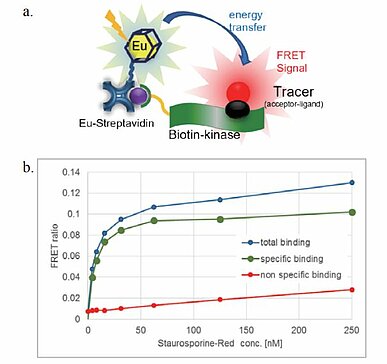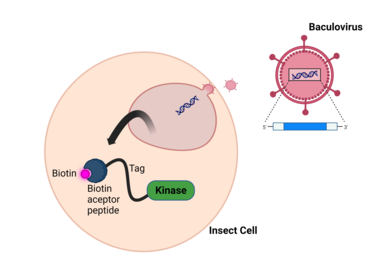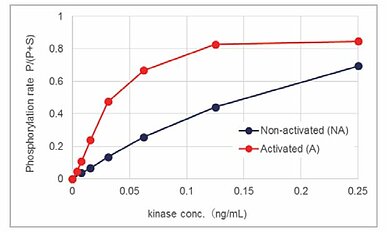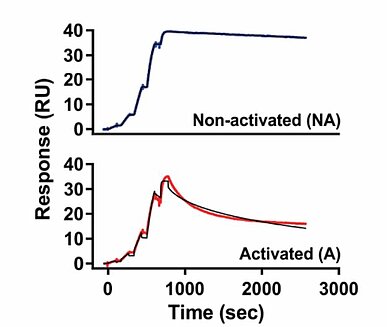Technical Note
Evaluating Kinase Inhibitors in Binding Assays using Activated and Non-Activated Biotinylated Kinases

Carna Biosciences Technical Note No. 1
The simplest and most straightforward way to evaluate a kinase inhibitor is to look at its inhibitory effect on the enzyme activity response. For this to be most useful and accurate, it is critical to establish the appropriate assay condition like ATP concentration and substrate (1). Issues can exist such as the availability of kinases with high enzymatic activity, and the inability to consistently produce them (2).
Binding assays
Binding assays, as an example, have also been deployed in the evaluation of small molecules targeting kinases. Unfortunately, compounds identified in these assays do not necessarily guarantee inhibition of enzyme activity, just as it is not possible to determine whether a receptor binder confirmed in a binding assay is an agonist or antagonist. Binding assays do however, alleviate some issues associated with activity-based enzymatic assays, in addition to having some unique merits. A quick review of a kinase-tracer competitive binding assay is shown in (Fig.1). Kits for these type of assays are already on the market such as HTRF® kits (cisbio / PerkinElmer) and LanthaScreen® kits (Thermo Fisher), using time-resolved fluorescence resonance energy transfer (TR-FRET) as their detection method. These mix-and-measure assays, while convenient, require tracers labeled with an optimal fluorescent material.
Surface plasmon resonance (SPR)
Also now widely used in binding assays is surface plasmon resonance (SPR) methodology which can determine the affinity and binding kinetics of a ligand (kinase inhibitor) to the target (immobilized kinase). SPR does not require a tracer and can be used to study binding at more than one site on the target kinase. Successful immobilization of the kinase is essential in both TR-FRET and SPR assays, for TR-FRET to the donor molecule, for SPR to the sensor chip where pre-labeled BTN kinases become highly useful. Although GST and His tags can be used in kinase immobilization, there are significant advantages to using the biotin-streptavidin combination due to its high affinity and selectivity (3). Carna continues to expand its portfolio of commercially available biotin-labeled kinases, using as a foundation its many years manufacturing GST- kinases. Carna’s biotinylated kinases (BTN-kinases) are made by inserting a DYKDDDDK tag at the N-terminus and adding a single biotin molecule(Fig.2) using an expression system inherently free of issues associated with chemical modification namely the inability to control the number of biotins added and the actual site of modification. Our expression and production methods yield a homogeneous and enzymatically active biotinylated kinase highly valuable for kinase inhibitor evaluations.
Carnas Biotinylated Kinases
Kinase binding assays such as non-competition assays can deliver some data even if the kinase conformation differs from that in the cell, however when evaluating compounds for potential drug applications, many consider physiologically similar structures more desirable. This is also our belief, making us committed to providing kinases, such as BTN-kinases with “enzymatic activity” assessed for each lot and described on our Production Information Sheet. We sometimes observe the occurrence of an insufficiently activated state or a lag phase in some kinases post-production. In these cases, we deploy various methods to increase activity (2), among these is treatment with ATP, resulting in increased enzymatic activity and elimination of the lag phase in most instances. (Fig.3)
Carna offers BTN kinases in non-activated forms (no ATP treatment) as well as those in activated forms (via ATP treatment), a step taken when required to enhance activity. This process by virtue of its nature, can modify the phosphorylation state of a kinase which can impact evaluation of drug candidates and clinical inhibitors when using SPR or other methods. From this point of view, our collaborator, Netherlands Translational Research Center B.V. (NTRC) investigated BTK inhibitors using Carna’s [activated] BTN-BTK (cat# 08-480-20N) and [non-activated] BTN-BTK(cat# 08-480-23N), the latter showing a 5 fold activity difference (Fig.3). Using these two kinases, three reversible kinase inhibitors targeting the ATP binding pocket (ARQ-531, vecabrutinib, fenebrutinib) were analyzed by SPR. ARQ-531 and vecabrutinib showed little difference in binding between the [activated] and [non-activated] forms. On the other hand, fenebrutinib demonstrated minimal dissociation after initial rapid binding to BTK [non-activated], whereas for BTK [activated], a plateau was observed following the rapid dissociation (Fig.4). These experiments revealed different drug kinase interactions can be exhibited depending on the presence or absence of activation by ATP. For details, refer to the NTRC website (Case study --BTK inhibitor fenebrutinib | Residence Timer ™) (4).
We continue to offer BTN kinases in both activated and non-activated forms as we feel both can be useful reagents for binding measurements. The availability of enzymatic preparations with heterogenous phosphorylation and activity states allow for expanded studies. SPR sensorgrams for Carna’s BTN kinases have been generated internally or provided by NTRC, and can be found on our website (5). If you have questions about any BTN kinase, such as did it undergo an ATP treatment process, or if BTN kinases not on the list are available on a custom basis, please feel free to contact us.




Further news
-
Newsletter
Cancer treatments using inhibitors of CDK, a cell cycle regulator
Read moreCarna Newsletter Vol.16
-
Newsletter
ALK drug resistant mutations: Challenges for the treatment of lung cancer
Read moreCarna Newsletter Vol.15
-
Technical Note
DGKα and DGKζ are key targets for cancer immunotherapy
Read moreCarna Newsletter Vol.14
